Solar busbars

Simple and compact solar busbars of FTG
Special solutions is the speciality
The fast wiring of a large number of fuses is required in distributors of photovoltaic systems. At the same time, the solution should not only be powerful, but also cost-effective to use. For the extensive and diverse range of photovoltaic busbars from the manufacturer FTG, located in Triberg, there are now also the inexpensive busbar versions.
From the planning phase of custom-made busbars, the most space-saving variants for the DC area are required. Basic requirements in the solar sector are conditions such as a maximum operating voltage of 1,500 V DC for single-pole busbars and 1,000 V DC for two pole busbars as well as a cable outlet on the busbar and different lengths. Customer-specific modifications are also taken into account because FTG is a specialist in unique solutions for one to four pole busbars.
With the predefined position of the connection terminal, press-in nut or threaded bolt on the busbars, wiring to the main switch can be carried out easily, quickly and safely. The cheaper option is to use the cable outlet using a threaded bolt and a crimp cable lug. The busbar offers the customer a price advantage for the same function. Furthermore, control cabinet builders do not have to purchase several parts, but only one product with two functions, which offers them a simple and quick installation.
As a specialist for connections in electrical engineering, FTG is at the customer’s side with its technical know-how in the planning phase. While support is provided in the development phase with 3D models, samples and drawings, FTG also creates the advertising material relevant to marketing for customers on request. For larger product series, all relevant tests can also be run with pre-series products. A solution is found for almost every customer requirement.
FTG exhibits at Light+Building in Frankfurt a. M. from 27th September to 2nd of October 2020 in Hall 12.0, Stand E90. Topics in focus are solar and photovoltaic as well as other trends such as aluminium and requirements of higher protection classes.
